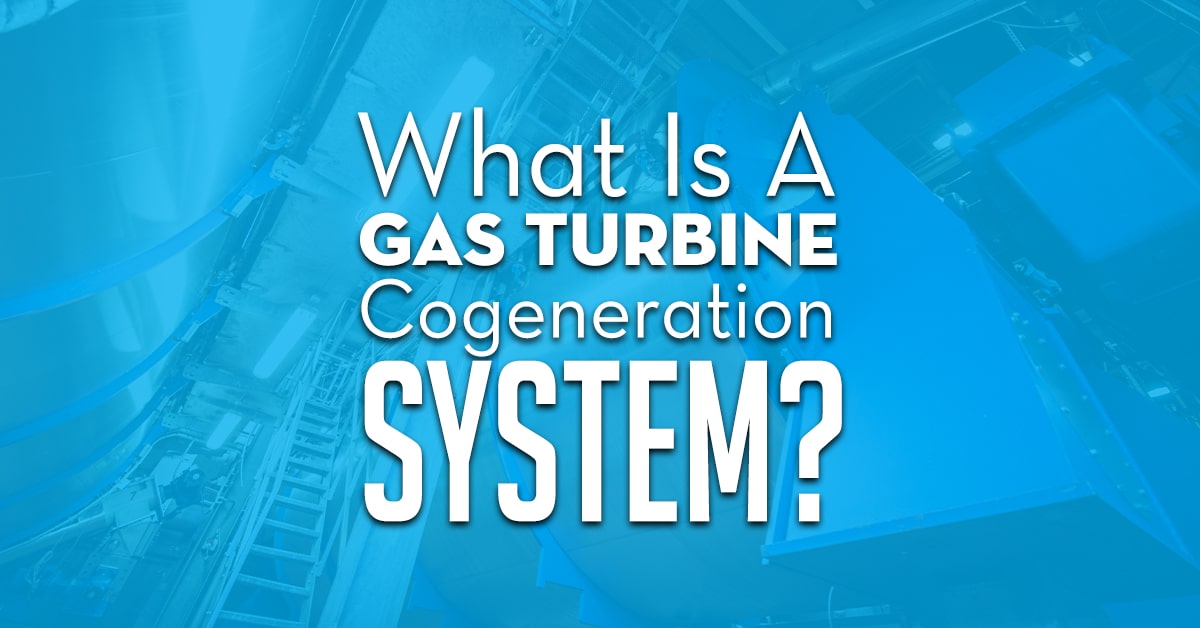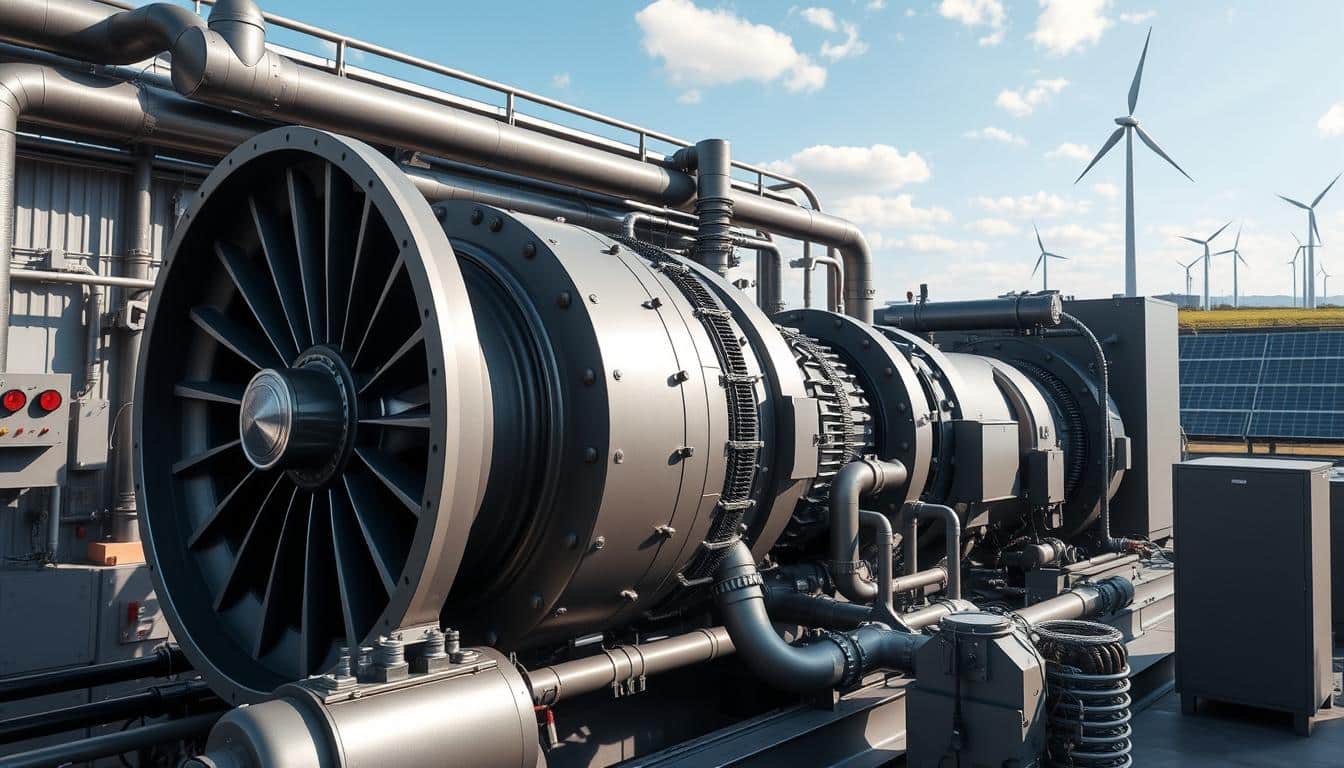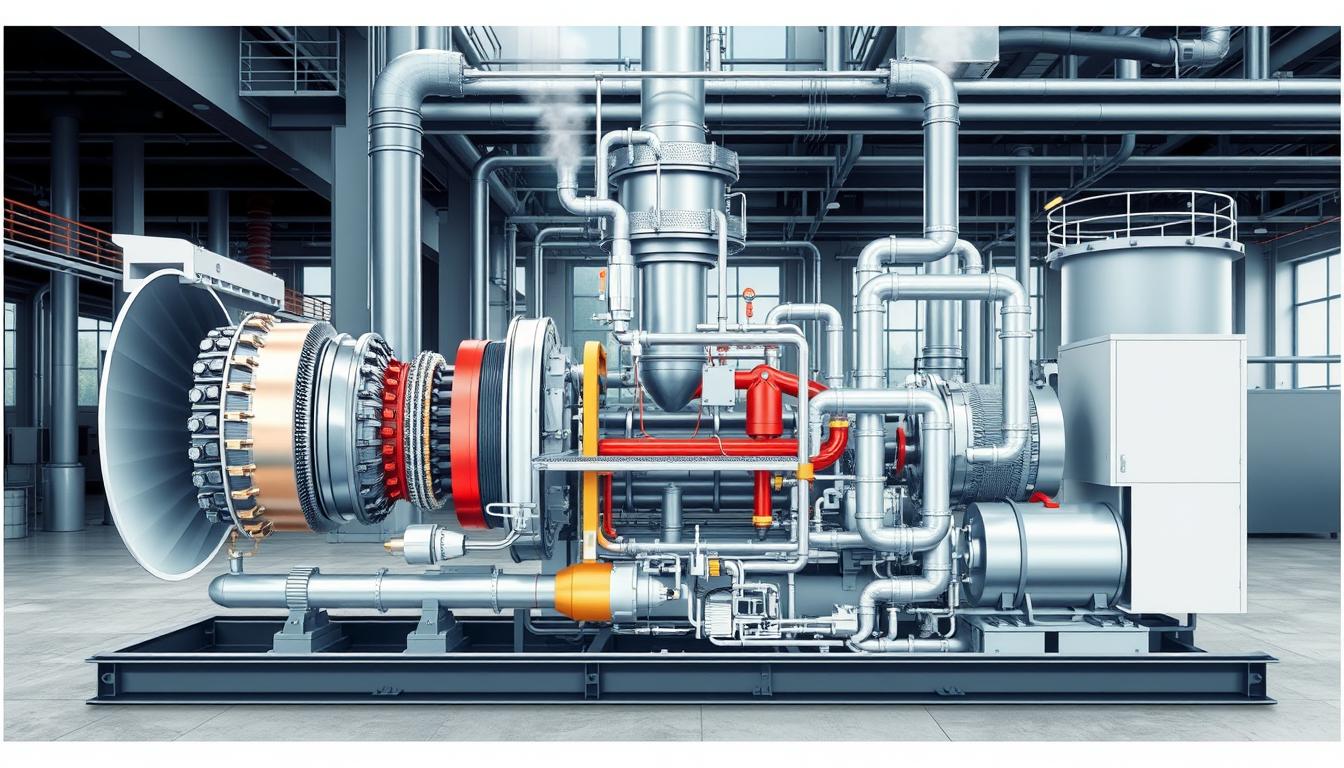Gas turbine cogeneration systems represent a cutting-edge approach to energy production, combining electricity and thermal energy from a single fuel source, often natural gas. This method has seen a surge in adoption due to its superior efficiency, reaching up to 90%. By harnessing waste heat from the turbine exhaust, these systems offer a cost-effective and eco-friendly option for industrial sectors.

The Kawasaki GPB Series has been a leading force in gas turbine cogeneration systems for over three decades. With over 700 installations globally, Kawasaki has solidified its reputation for excellence and reliability. Their gas turbines incorporate advanced Dry Low Emission (DLE) combustors, ensuring NOx emissions are significantly below regulatory thresholds in many jurisdictions.
The adaptability of gas turbine cogeneration systems is showcased by their capability to operate with diverse fuel sources, including urban gas, natural gas, LPG, kerosene, diesel, and fuel oil A. This versatility allows for flexibility in response to fuel availability and pricing fluctuations. These systems can initiate operation using liquid fuel, ensuring continuous power supply even during grid failures.
In Japan, the demand for cogeneration technology is on the rise, with projected power generating capacity from cogeneration systems set to increase from 9,400 MW in 2010 to 21,500 MW by 2030. This growth could potentially meet 15% of Japan’s power needs. The International Energy Agency (IEA) endorses cogeneration as a vital technology for combating global climate change and meeting escalating power demands.
Key Takeaways
- Gas turbine cogeneration systems generate electricity and thermal energy simultaneously, achieving overall efficiencies of up to 90%.
- Kawasaki GPB Series has delivered over 700 systems worldwide, featuring advanced DLE combustors for reduced emissions.
- These systems can operate using various fuel types and perform black-out starts during power outages.
- Cogeneration power generating capacity in Japan is expected to reach 21,500 MW by 2030, covering 15% of the country’s power demand.
- The IEA recognizes cogeneration as a reliable technology for addressing climate change and increasing power demand.
Overview of Gas Turbine Cogeneration Systems
Gas turbine cogeneration systems, also known as combined heat and power (CHP) systems, represent a highly efficient and cost-effective method for generating electricity and thermal energy from a single fuel source. These systems capture and utilize waste heat from the gas turbine exhaust. This results in overall efficiency levels ranging from 65% to 90%, significantly surpassing traditional power generation methods.
Definition of Cogeneration
Cogeneration, or CHP, involves the simultaneous production of electricity and useful thermal energy from a single primary energy source. This process captures waste heat generated during electricity production. It then utilizes this heat for various applications, such as heating, cooling, or industrial processes. By harnessing this waste thermal energy, cogeneration systems enhance energy efficiency and reduce overall energy costs.
Primary Components of a Gas Turbine Cogeneration System
A gas turbine cogeneration system comprises several key components essential for generating electricity and recovering waste heat:
- Gas Turbine: The primary energy source, typically natural gas or other fuels, drives the gas turbine. It produces electricity and high-temperature exhaust gases.
- Generator: Coupled with the gas turbine, the generator converts the mechanical energy from the turbine into electrical energy.
- Heat Recovery Steam Generator (HRSG): The HRSG captures the waste heat from the turbine exhaust gases. It generates steam, which can be used directly for process heating or to drive a steam turbine for additional power generation.
- Steam Turbine: In some cogeneration systems, the steam generated by the HRSG drives a steam turbine. This produces additional electricity and further enhances overall system efficiency.
By integrating these components, gas turbine cogeneration systems can achieve fuel savings of up to 40% compared to separate electricity and thermal energy production methods. This increased efficiency not only reduces energy costs but also contributes to lower emissions and a smaller environmental footprint.
How Gas Turbine Cogeneration Systems Work
Gas turbine cogeneration systems are engineered to optimize energy efficiency. The process starts with fuel combustion in the gas turbine, which powers the turbine to generate electricity. The hot exhaust gases are then recovered and used for various applications, such as process heating, space heating, or powering an absorption chiller for cooling.
Fuel Input and Combustion Process
The primary fuel for these systems is typically natural gas. Kawasaki’s combustion technology supports various fuel types, including urban gas, LPG, kerosene, diesel, and fuel oil A. The fuel combustion in the gas turbine produces high-temperature, high-pressure gases. These gases expand through the turbine stages. Kawasaki’s Dry Low Emission (DLE) combustor ensures NOx emissions are below regulatory levels in many regions.
Electricity Generation
The expansion of the hot gases drives the turbine, which is connected to a generator. This setup produces electricity. The electrical power output varies by model, ranging from 650 kW to 28,350 kW. In combined systems, an additional steam turbine can generate about 16,000 kW, boosting the overall electrical power output.
Heat Recovery and Utilization
The hot exhaust gases from the turbine are directed to a heat recovery steam generator (HRSG). Here, the waste heat is converted into steam. This steam can be used directly for process heating, space heating, or to drive a steam turbine for more power generation. Typical steam conditions in Kawasaki gas turbine systems are at a pressure of 0.83 MPaG and a saturated steam temperature of 177℃, with a supply rate of approximately 65 t/h in specific generator setups. The recovered thermal energy can also power an absorption chiller, enabling trigeneration (combined cooling, heat, and power) for space cooling.
By efficiently utilizing both electrical and thermal energy from fuel combustion, gas turbine cogeneration systems achieve a total thermal efficiency of 80% to 90%. This significantly reduces energy waste and enhances overall energy utilization.
Benefits of Gas Turbine Cogeneration
Gas turbine cogeneration systems present numerous advantages, making them a preferred option for energy conservation and cost reduction. These systems harness waste heat, achieving efficiencies up to 90%. This results in a notable decrease in fuel usage, often by as much as 40% compared to separate generation methods.
The enhanced efficiency of gas turbine cogeneration leads to lower operational costs for industrial entities and other consumers. For instance, the University of Texas at Austin has achieved remarkable plant reliability with GE Vernova’s CHP application. This has enabled the conditioning of 18 million square feet of space. Such reliability and cost savings are invaluable for institutions such as hospitals, universities, and military bases.
Energy Efficiency Improvements
Gas turbine cogeneration systems leverage heat and steam to produce additional power, reducing fuel needs. Offshore combined-cycle gas turbine (CCGT) systems typically achieve efficiencies around 50%. Onshore CCGTs, on the other hand, range from 50% to 63%. These figures underscore the substantial energy efficiency gains over traditional power generation methods, such as open-cycle gas turbines (OCGTs), which have efficiencies between 33% and 43%.
Cost Savings and Economic Advantages
The enhanced energy efficiency of gas turbine cogeneration results in lower operational costs due to reduced fuel consumption. These savings are considerable, given the high costs associated with greenhouse gas emissions. The life-cycle costs of CCGTs can be more favorable when fuel consumption is low and saleable hydrocarbons are increased. Despite higher capital and maintenance costs compared to OCGTs, the improved energy efficiency and lower operating expenses (OPEX) make CCGTs more economical.
Environmental Benefits and Reduced Emissions
Gas turbine cogeneration promotes the use of clean energy, reducing the carbon footprint of power generation. By utilizing waste heat and lowering overall fuel consumption, these systems significantly reduce greenhouse gas emissions. The use of clean-burning natural gas further enhances environmental sustainability. The distributed generation capabilities of gas turbine cogeneration also improve energy security and alleviate the strain on the power grid.
Applications and Industries Utilizing Gas Turbine Cogeneration
Gas turbine cogeneration systems have become integral across diverse industries, thanks to their efficiency and reliability in producing both electrical and thermal energy. This technology has seen a surge in adoption, with sectors like chemical plants, refineries, food processing facilities, and paper mills benefiting from it. They use it to fulfill their energy requirements, cut costs, and lessen environmental impact.
In the oil and gas sector, gas turbines are essential for driving compressors and generators, ensuring pipeline pressure over vast distances. Cogeneration plants equipped with gas turbines can boost energy efficiency by up to 90% by utilizing waste heat for industrial processes. This heat recovery is invaluable in sectors like food processing and paper mills, where process steam is a critical need.
Gas turbine cogeneration systems are also utilized in hospitals, universities, and district heating systems. These entities require substantial amounts of electricity and heat, making cogeneration a perfect fit for their energy demands. Combined cycle power plants further elevate the efficiency of gas turbine cogeneration. They use the steam from the heat recovery steam generator (HRSG) to power a steam turbine, achieving overall plant efficiencies of 60% or more.
The demand for small gas turbines (5 to 65 MW) for cogeneration, peak shaving, and distributed generation is increasing among industrial self-generators and electric companies. The promise of cost savings through mass production and technological progress positions gas turbine cogeneration to play a more significant role. It will help meet the energy needs of various sectors while promoting sustainability and cost-effectiveness.
Conclusion
Gas turbine cogeneration systems have proven to be a vital solution for various industries, promoting energy sustainability and efficiency. These systems generate both electricity and thermal energy from a single fuel source. This significantly reduces energy costs and enhances energy security, contributing to the decarbonization of the energy sector. As industries focus on industrial energy efficiency and environmental stewardship, the adoption of gas turbine cogeneration technology is expected to increase. It will play a key role in the energy transition towards a sustainable future.
Natural gas, emitting 50 to 60% less CO2 than traditional coal-fired power plants, is set to maintain a significant market share for the next 15 to 20 years. Gas turbine power plants require less capital investment than traditional coal-fired plants, with simple cycle plants generating power on demand without the startup time of coal or nuclear plants. Combined cycle plants, though more efficient, may have longer startup times.
Turbine Inlet Air Cooling (TIAC) systems enhance power output, even in high ambient temperatures, and their adoption is increasing. TIAC systems can be fueled by waste heat from turbines, improving overall efficiency. Their installation cost is less than a new turbine or peaking plant, making them a cost-efficient choice. Cogeneration with supplementary firing can increase power output by 17%, while it increases by 5% without it, compared to gas-turbine-only operation. The energy utilization factor improves by 27–37% without supplementary firing and exceeds 37% when used, contributing to the overall efficiency of distributed energy resources.
Advancements in gas turbine technology, such as fuel flexibility and emissions reduction, will further enhance the benefits of cogeneration systems. The successful testing of a gas turbine with a hydrogen blend containing up to 25% in Germany in 2022 shows the system’s stable performance and low emissions. With ongoing support, like the European Commission’s EUR 752 million allocation for promoting high-efficiency cogeneration in Romania, gas turbine cogeneration systems are set to play a vital role in global energy sustainability and decarbonization efforts.
Frequently Asked Questions
What is a gas turbine cogeneration system?
A gas turbine cogeneration system is a cutting-edge energy solution. It generates both electricity and thermal energy from a single fuel source, typically natural gas. This system includes a gas turbine, generator, and heat recovery equipment. It captures and utilizes waste heat from the turbine exhaust, making it highly efficient.
How does a gas turbine cogeneration system work?
In a gas turbine cogeneration system, fuel, usually natural gas, is combusted in the gas turbine. This combustion creates high-temperature, high-pressure gases. These gases expand through the turbine stages, driving it and coupled to a generator to produce electricity.
The hot exhaust gases from the turbine are then directed to a heat recovery steam generator (HRSG). Here, the waste heat is used to generate steam. This steam is for process heating, space heating, or additional power generation.
What are the main components of a gas turbine cogeneration system?
The key components of a gas turbine cogeneration system are the gas turbine, generator, heat recovery steam generator (HRSG), and steam turbine. The gas turbine generates electricity. The HRSG captures waste heat from the turbine exhaust to produce steam.
This steam can be used directly or to drive a steam turbine for additional power generation. This setup maximizes energy efficiency and utilization.
What are the benefits of gas turbine cogeneration?
Gas turbine cogeneration systems offer significant benefits. They increase energy efficiency up to 90%, reduce operating costs, and lower environmental impact. By utilizing waste heat, these systems result in substantial fuel savings and reduced greenhouse gas emissions.
The high efficiency also leads to lower energy costs for industrial facilities and other users. This makes cogeneration an attractive option for many industries.
What industries commonly use gas turbine cogeneration systems?
Gas turbine cogeneration systems are widely used across various industries. These include chemical plants, refineries, food processing facilities, paper mills, hospitals, universities, and district heating systems. These sectors require significant amounts of both electrical and thermal energy.
Given their energy needs, cogeneration is an ideal solution. It helps meet these needs while reducing costs and environmental impact.
How does gas turbine cogeneration contribute to sustainability?
Gas turbine cogeneration systems contribute to sustainability in several ways. They significantly reduce energy costs, improve energy security, and contribute to the decarbonization of the energy sector. The use of clean-burning natural gas and reduced fuel consumption lead to a smaller carbon footprint.
Improved environmental sustainability is a direct result of these systems. They play a vital role in promoting a greener future.

